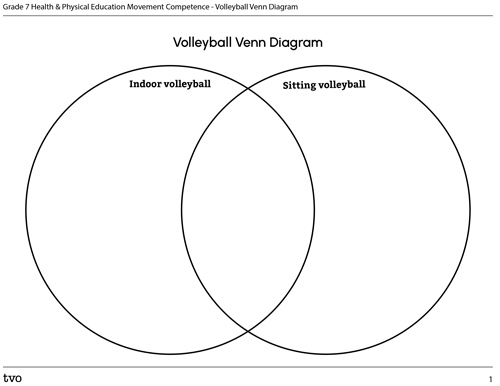Minds On
What do you know and wonder?

In this learning activity, you will be learning all about volleyball as well as another game called sepak takraw that is closely related to it. You will be learning about the equipment, the games and the skills required. Let’s check what you already know and what you wonder about volleyball.
To organize your thoughts, complete the KWL Chart in your notebook or using the following fillable and printable document. If you would like, you can use speech-to-text or audio recording tools to record your thoughts.
| KWL Chart | ||
|---|---|---|
| Topic: Volleyball | ||
| What I KNOW | What I WONDER | What I LEARNED |
Press the ‘Activity’ button to access KWL Chart.
Fill out the “K” and the “W” columns now. You may use the “L” column to record what are some things you learn from the Action section.
Action
The game: volleyball
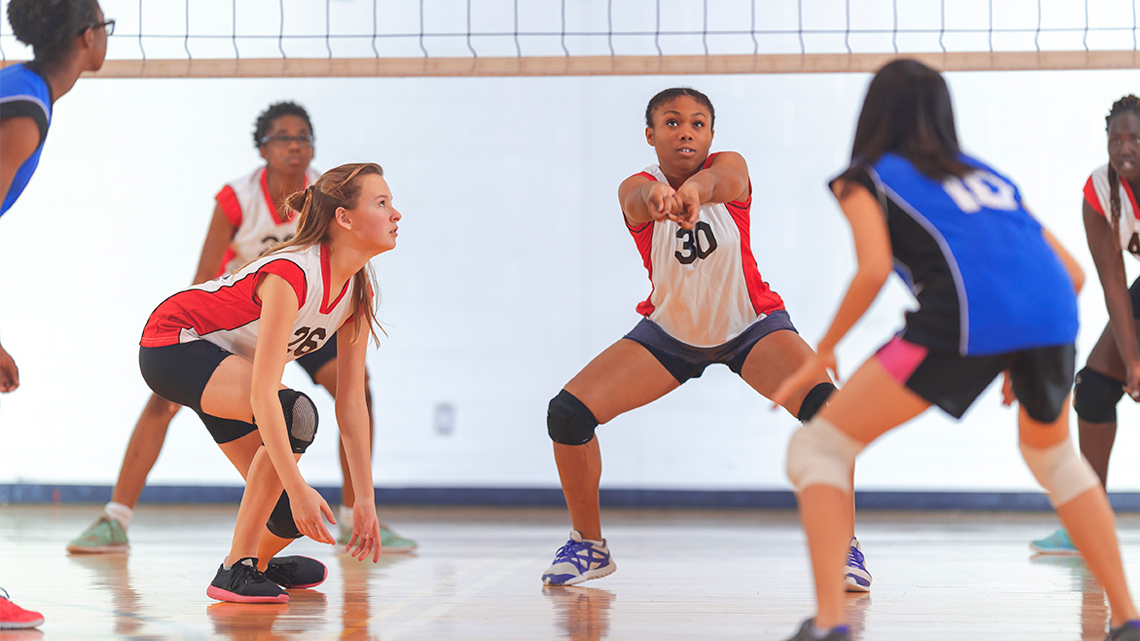
Playing Volleyball
Volleyball is a net/wall activity. Let’s take some time to learn more about the sport before working on two skills in the game.
Press the following tabs to access the various components of volleyball.
- a volleyball
- a volleyball net
Explore the following diagram for the court dimensions and set-up.

A volleyball court
A volleyball court is a rectangular shape that is 9 metres by 18 metres. In the centre of the longest side is the volleyball net, which stretches across the court and is marked with the centre line. The volleyball net height varies between 2.24 metres and 2.43 metres.
Each side of the court is separated into a front zone and a back zone. The areas directly beside the net are the front zones for each team. The front zone extends from the centre line to 3 metres from the net in both directions.
The remaining zones at the back of the court on both sides are called the back zones and take up the remaining 6 metres of the court. The line between the front zone and the back zone is labelled as the attack line. The line at the very back of the back zone is labelled as the back line.
The lines on the sides are labelled as the side lines. There is a service area at the back right of each back zone that is 3 metres wide and 3 metres deep. The service area is where volleyballs are served from, and is labelled as the serving line.
- Each team will have six members on the court in a given time.
- One team starts by serving the ball behind the serving line.
- Then the opponents aim is to return the ball using a bump, set, and/or spike. Each team can touch the ball up to three times when it is returned to their side, but a player can only touch once.
- Play keeps going until rally ends (when a ball hits the ground or goes out of bounds). The team that ends the rally gets one point.
- The team that won the last point can serve and start another rally.
- The set keeps going until one team has scored 25 points with a two-point lead.
The main skills in volleyball include setting, serving, spiking/attacking, blocking, passing, and digging.
Did You Know?
Sitting volleyball
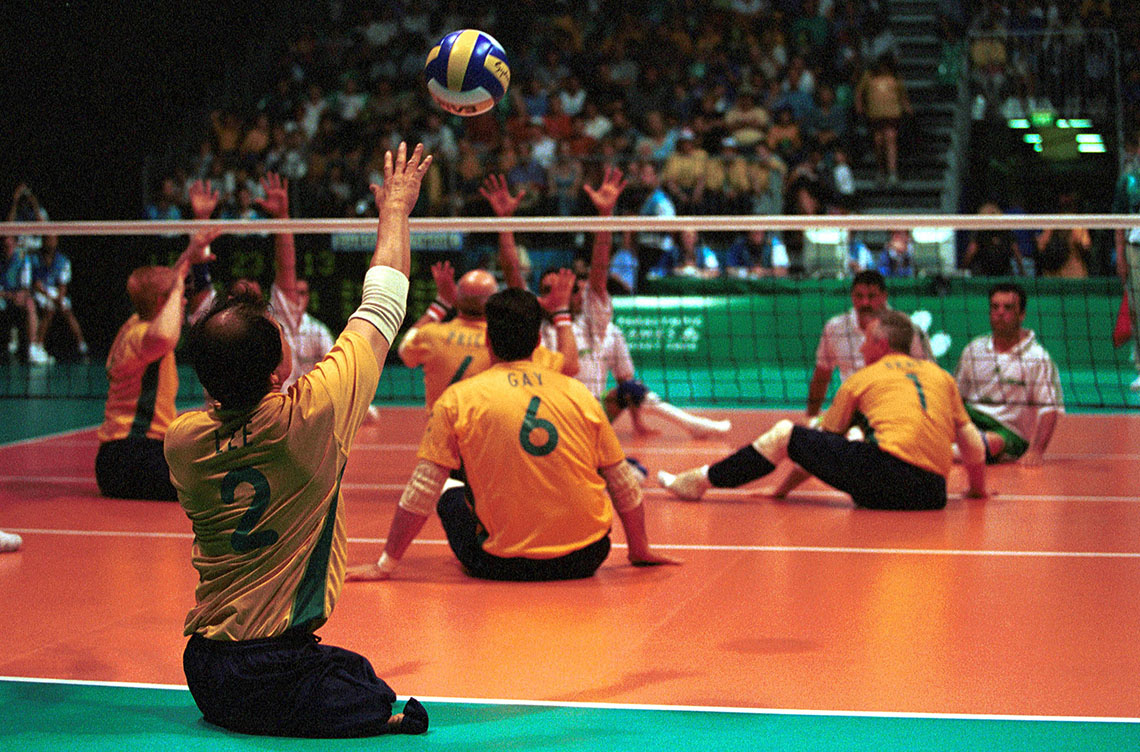
Sitting volleyball was created in Netherlands in the 1950s as a rehabilitation sport for soldiers with lower body injuries. It was officially introduced in the Summer Paralympic games in the 1980 games for men in Arnhem and in the 2004 games for women in Athens. The dimensions of the court in sitting volleyball are smaller and the net is lower than the typical volleyball set up. In terms of the game rules, they are the same as regular volleyball except that players need to keep their bottom in contact with the floor.
Sepak takraw: kick volleyball
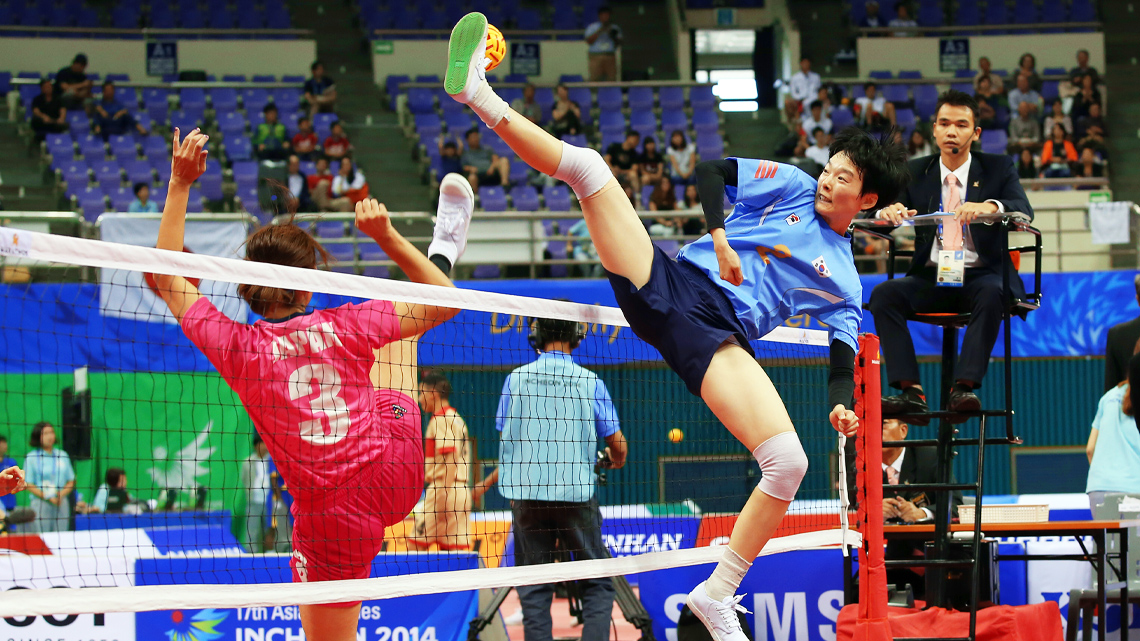
Sepak takraw
Now let’s learn a bit about Sepak Takraw. This sport is a version of volleyball where players use their feet to play instead of their arms. Sepak means kick in Malay and takraw means woven ball in Thai.
Press the following tabs to learn more about the various components of sepak takraw.
- a hand-woven rattan ball
- a net that is about the height of a badminton net
Explore the following diagram for the court dimensions and set-up.

A sepak takraw court
A sepak takraw court is 6.1 metres by 13.4 metres. The court is divided halfway through its longest side by the net and the centre line. The net is 1.52 metres high.
There is a quarter of a circle with a radius of .9 m at the outer edges of the centre line, which is labelled as 'The Quarter Circle.'
On each side of the court there is a .3 metre radius circle labelled as the 'Service Circle.' The Service Circle is 3.05 metres from the sides of the court, and is 2.45 metres from the back of the court.
- A coin flip determines which team will serve first.
- The player that is serving the ball will serve in the serving circle. The other two players on the team will stand in the other two quarter circles that are next to the net. The ball will be tossed by one of the other two players to the server for them to kick it and start play. All players have to stay within their circle during the serve or they will lose points. The server is only required to have one leg in the service line.
- The rally starts when a successful serve has been made across the net. Each team will try to defend and pass the ball across to the opponent’s side.
- When the ball is returned, the team can touch the ball up to three times until it has to be returned. Touches by the same player are allowed.
- There are usually three positions: a server, a feeder, and a striker. The feeder and server will move around the court to set the ball up for the striker to return the ball to the opponent’s side.
- Play keeps going until rally ends (when a ball hits the ground, goes out of bounds, is touched more than three times, or makes contact with a player’s hands). The team that ends the rally gets one point.
Serving up skills!
Now let’s get active and learn some of the skills involved in both volleyball and sepak takraw by practising them through some drills.
Safety
Before you begin, consider these safety precautions:
Warm Up
Warm up
Let’s do a warm up before we get into our main activities! Warm ups will help you better perform a movement/activity while also greatly reducing your chance of injury.
Depending on what activities you are performing, choose one of the following warm ups, or you may do a combination of them.
Press the following tabs to access the warm ups.

- Jogging: start off with a relaxed jog for 5 minutes. You can jog in one place or back and forth in your space.
- Jumping jacks: Now do 10 jumping jacks! To perform a jumping jack, position your body straight up with hands to your sides. Then jump and spread legs apart and bring arms above the head. After that, jump back into starting position.
- Toe touch: Time to touch our toes! Have your body straight up. Then lean and bend forward and try your best to touch your toes. Hold the position for 10-20 seconds, return to straight upward position and repeat 10 times.
- Sit-up: Now do 10 sit-ups! To set-up a sit-up, lay on your back and bend your knees to form a ‘V’ shape with your legs. Bend your upper body towards your knees to perform the sit-up.
- Mountain climber: Finally, do the mountain climber for 60 seconds. To perform the mountain climber set yourself up in the push up position, then bring each knee forward as if you were climbing.

- Neck Tilts and Rotations: Slowly tilt your head side to side 10 times and then slowly and carefully rotate your neck 10 times in each direction.
- Arm Circles: Straighten your body and put your arms straight out to the sides. Then start forming circles in one direction, start with small circles and work your way up to large circles. Do this 10 times and then repeat with the opposite direction.
- Chest Expansions: Straighten your body and put your arms out straight to the sides with palms of hand facing forward. Bring your hands together in a clapping motion slowly, then return to the starting position. Do this 10 times.
- Wrist Circles: Clasp your wrists together and start to circle your wrists in one direction. Do this 10 times and then repeat with the opposite direction.
- Shoulder Rolls: Put your arms to the side keeping your posture straight. Rotate your shoulders forward to make a circle. Do this 10 times and then repeat with the opposite direction.

- High Knee Jog: Standing straight with shoulder-width apart perform a jog but raise your knees to about waist level. Do this for two minutes.
- Side-to-Side Hops: Standing straight with hands to side and feet hip-width apart hop side to side quickly. Do this for two minutes.
- Lunges: Stand straight with feet hip-width apart and arms grabbing the side of your hips. Take a step forward and bend your knees so that you form two 90-degree angles with your legs with one leg forward and one leg behind. Hold the position for 20-30 seconds then switch legs and repeat. Do this three times.
- Squat Side Kick: Go into a squat position so that your feet are shoulder-width apart and your hips are back. Then gradually get up and shift your weight towards one leg so that you can lift your other leg out to the side in a slow kick motion. Then return to the squatting position. Do this 10 times for each leg.
- Lateral Leg Swing: Stand upright, holding onto a wall with one hand for support and the other hand placed on the side of your hip. Swing one leg in front carefully across your body from side to side for 10 times. Then repeat with other leg.
Skills
Press the following tabs to access information about skills for volleyball.
Serves up! Let’s learn about serving, one of the most important skills to start a rally in volleyball.
Explore the following video for a step-by-step on how to perform an underhand serve. As you explore, consider how you would describe and explain the various phases of movement (preparation, execution, and follow through) for this motion.
A demonstration of the four steps of serving a volleyball.
The first step is preparation. A person holds a volleyball in one hand and extends the arm with the volleyball in front of their body.
They also step forward with the leg on the same side. They take their opposite free hand and move it backwards.
The second step of preparation involves the person moving their free hand towards the volleyball they are holding in their other hand.
The third step is execution, where the free hand moves forward and strikes the volleyball.
The fourth step is followed through, where the person’s striking hand has made contact with the volleyball and continues to move forward to follow the moving ball.


The first step is preparation. A person holds a volleyball in one hand and extends the arm with the volleyball in front of their body. They also step forward with the leg on the same side. They take their opposite free hand and move it backwards. The second step of preparation involves the person moving their free hand towards the volleyball they are holding in their other hand.
 The third step is execution, where the free hand moves forward and strikes the
volleyball.
The third step is execution, where the free hand moves forward and strikes the
volleyball.
 The fourth step is followed through, where the person’s striking hand has made
contact with the volleyball and continues to move forward to follow the moving ball.
The fourth step is followed through, where the person’s striking hand has made
contact with the volleyball and continues to move forward to follow the moving ball.
This is a drill you can use to practise your underhand serving.
Equipment and setup:
- A volleyball or any ball that is safe to hit. You may also crumple paper into a ball or roll a piece of cloth/sock into a ball.
- Volleyball net and court (optional). You may also use a rope and tie it to two chairs to make a makeshift net.
- Use something such as chalk, t-shirts, cloth, hula hoops, or string to mark target locations. These targets should be approximately the distance required for a ball to travel from the back line to some distances within the boundaries of where the opponents’ side of the field is. You may adjust the distance and size of your target to something that will be just enough to challenge you.
The drill:
- Underhand serve and try to aim at the targets you have created.
- To measure your performance, you can record how many attempts out of a specific number of serves end up within the target area.
Press the following tabs to access information about skills for sepak takraw.
Explore the following video for a demonstration of how to perform an inside kick for sepak takraw. As you explore, consider how you would describe and explain the various phases of movement (preparation, execution, and follow through) for this motion.
Check out the following video to learn more about an inside kick
There are four main motions to perform an inside kick for sepak takraw.
The first step is preparation, where a player is getting ready to hit the ball. The player has their hands to the side and their feet planted on the ground. The player is looking at the ball.
The second step is preparation/execution. The player’s foot moves inwards and upwards towards the ball and makes contact.
The third step is execution/follow-through: After contact, the ball moves upwards, and the foot is moving back into ready position.
The fourth step is follow-through, where the player returns to a ready position where their hands are to the side and their feet are planted on the ground about shoulder width apart.

There are four main motions to perform an inside kick for sepak takraw. The first step is preparation, where a player is getting ready to hit the ball. The player has their hands to the side and their feet planted on the ground. The player is looking at the ball.

The second step is preparation/execution. The player’s foot moves inwards and upwards towards the ball and makes contact.

The third step is execution/follow-through: After contact, the ball moves upwards, and the foot is moving back into ready position.

The fourth step is follow-through, where the player returns to a ready position where their hands are to the side and their feet are planted on the ground about shoulder width apart.
This is a drill you can use to practise your inside kick.
Equipment and setup:- A ball or round object that is about the size of your head that is safe to kick. You may also crumpled paper into a ball or roll a piece of cloth/sock into a ball.
The drill:
- Juggle the ball using the inside kick and alternate between each leg
- Challenge yourself and find out how many times you can perform an inside kick without dropping the ball.
Try It
Practice makes perfect
If you can, try out one of the skills that were covered. Remember to do your safety checks before you begin!
Then pause and reflect on the following prompts:
- What could be the reason for your serves not to go to the intended targets or when you end up dropping the ball when trying to juggle it using an inside kick?
- How does speed and force affect your ability to control where the ball is going?
- How can you improve on your technique in the skill?
Record your thoughts using a method of your choice.
Cool Down
Cool down
Now it’s time for a cool down! It’s important to allow your body to gradually return to a resting state after intense physical activity.
Remember to perform your safety check before you begin.
Depending on what activities you are performing, choose one of the following cool downs, or you may do a combination of them.
Press the following tabs to access the cool downs.

- Jogging: Begin with a jog and transition to a walk. Do this for 2-5 minutes.
- Wide Toe Touch: Now do wide toe touches for 60 seconds. To perform a wide toe touch, position your body in the shape of a star, then bend forward and reach with one arm to touch the opposite foot. The other arm which is on the same side as the foot is pointed upwards. Hold this position for 10-15 seconds, then return to the starting position and repeat on the opposite side.
- Quad Stretch: Stand up straight and shift your weight to one leg. Then lift your other leg backwards towards your butt and grab it with the arm on the same side. Hold it for 20-30 seconds and repeat with the other leg. Do this 5 times for each leg.
- Child’s Pose: Do the child pose for 30 seconds. To perform the child pose, get down on your knees and bend your body forwards stretching your arms out. Your forehead should be resting on the floor.
- Abdominal Stretch: Now, do an abdominal stretch for 30 seconds. To perform the abdominal stretch, lie face down with legs straight up and place your arms in a push up position. Push upwards and slowly lift your torso holding the position.

- Shoulder Stretch: Bring one arm across your chest bend your other arm to help support it into position. Hold the position for 30 seconds and then do the opposite side. Repeat three times.
- Triceps Stretch: Bend one arm up and behind towards your shoulder blade. Use the other arm to help support it into position. Hold the position for 30 seconds and then do the opposite side. Repeat three times.
- Overhead Stretch: With your body straight interlock your fingers and bring your arms above your head. Have your palms facing away from you. Hold the position for 60 seconds.
- Torso Stretch: With your body straight fold one arm behind your back and use the other arm to help support it into position. Then bend your torso towards one side. Hold the position for 30 seconds and then do the opposite side. Repeat three times.
- Chest-Cross Arm Swing: With your body straight put your hands horizontally straight out to the sides and then swing your arms to make an ‘X’ shape back and forth for 60 seconds.

- Flutter Kick: Lie on your back with your hands to the side. Lift your legs and perform a kicking motion, alternating the legs back and forth. Do this for one minute.
- Side-Lying Leg Lifts: Lie on your side with one arm supporting your head and one arm bend in front supporting your body in position pushing against the ground. Lift your leg slowly and gradually return it back. Do this five times and then switch to the other leg.
- Single Leg Hug: You can do this lying on your back or standing straight up. With your arms hug your thigh to bring one knee towards your chest. Hold the position for 20-30 seconds then gradually release and switch sides. Repeat three times.
- Butterfly Stretch: Sitting on the floor bring both feet together so they are touching. Use your arms to safely move your knees towards the floor. Hold the position for 20-30 seconds and then release gradually. Repeat three times.
- Hip Flexor Stretch: Kneel on one of your knees and bend your other leg in front of your body at approximately a 90-degree angle. Shift your weight forward until you feel a stretch. Hold the position for 20-30 seconds and switch sides. Repeat three times.
What I learned
Now let’s return to the KWL Chart we started in the Minds On section of the learning activity.
First, reflect on the “W” column. Did the information provided answer anything you were wondering about?
Then, record what you have learned in the “L” column in the chart. You may also add more to the “W” column if you still have things you are wondering about.
Consolidation
Match it!
Let’s review what we’ve learned about underhand serving using the following matching activity.
For each step, select the corresponding image from the drop-down menu.
Let’s review what we’ve learned about inside kicks using the following matching activity.
For each step, select the corresponding image from the drop-down menu.
Compare and contrast
You learned about volleyball and sepak takraw. Now it’s time to reveal what you know by comparing and contrasting the two sports. Consider the following questions to help guide your thinking:
- What are the similarities between the two sports?
- What are the differences between the two sports?
- When were each of the sports introduced?
Complete the following Volleyball and Sepak Takraw Venn Diagram in your notebook or using the following fillable and printable document. Fill in the Venn diagram to identify the characteristics of volleyball in one circle, the characteristics of sepak takraw in the other circle, and the common characteristics between these two sports in the overlapping area. If you would like, you can use speech-to-text or audio recording tools to record your thoughts.
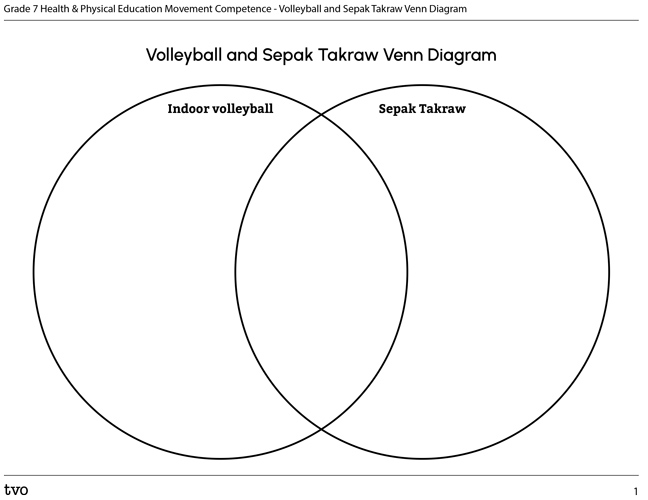
Press the Activity button to access Volleyball and Sepak Takraw Venn Diagram.
Activity (Open PDF in a new tab)Reflection
As you read the following descriptions, select the one that best describes your current understanding of the learning in this activity. Press the corresponding button once you have made your choice.
I feel...
Now, expand on your ideas by recording your thoughts using a voice recorder, speech-to-text, or writing tool.
When you review your notes on this learning activity later, reflect on whether you would select a different description based on your further review of the material in this learning activity.
Press 'Discover More' to extend your skills.
Discover MoreIndoor volleyball and sitting volleyball
In the Action section, you were provided some brief information about sitting volleyball. You will now do some further research and compare the Olympic sport of indoor volleyball with the Paralympic sport of sitting volleyball. Here are some prompts to guide your research:
- What are the similarities between the two sports?
- What are the differences between the two sports?
- When were each of the sports introduced?
Complete the Volleyball Venn Diagram in your notebook or using the following fillable and printable document. Fill in the Venn diagram to identify the characteristics of indoor volleyball in one circle, the characteristics of sitting volleyball in the other circle, and the common characteristics between these two sports in the overlapping area. If you would like, you can use speech-to-text or audio recording tools to record your thoughts.
